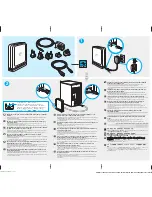
Appendix B. Campbell Scientific File Formats
Header line five describes the processing performed in the datalogger to
produce the value for each field in the record; for example, sample, average,
min, max, etc. If there is no known processing for a field, that field will be
assigned an empty processing string. There will be one value on this line for
each field name given on header line three.
Header line six defines the data types for each field in the record and supports
the following values: IEEE4, FP2, ULONG, LONG, SecNano, and ASCII(len).
TOB2 frame headers are eight bytes long and hold the timestamp for the first
record in the frame. TOB3 frame headers are twelve bytes long and contain the
same timestamp information but also add a four-byte unsigned integer that
represents the beginning record number for that frame.
The frame data begins immediately following the frame header and consists of
zero or more data records. Each record contains one data point for each of the
field names identified in header line three. The data type and implied size of
these data points are identified by the data types list given by header line six.
The frame footer makes up the last four bytes of the frame.
B.3 Binary Data Value Types
When data is written in datalogger memory or in binary data files each value
must be assigned a particular data type. These data types describe the format
of the data.
B.3.1 FP2 (2 Byte Low Resolution Format)
A two-byte floating-point number format created by Campbell Scientific, Inc.
and used to store low-resolution values. Appendix C of the CR10X datalogger
manual describes this format in greater detail. Basically, this format consists of
a single sign bit, a two-bit negative decimal exponent, and a 13-bit mantissa.
B.3.2 FP4 (4 Byte High Resolution Format)
A four-byte floating-point number format created by Campbell Scientific, Inc.
and used for input location values as well as high-resolution final storage
values. This format consists of a single sign bit, a seven-bit base-two
exponent, and a 24-bit mantissa.
B.3.3 IEEE4
A standard four-byte floating-point number format used for certain values
within a record. This format consists of a single sign bit, an eight-bit binary
exponent, and a 23-bit mantissa.
B.3.4 IEEE8
A standard eight-byte floating-point number format used for certain values
within a record. This format consists of a single sign bit, an 11-bit exponent,
and a 52-bit mantissa.
B-21
Summary of Contents for LoggerNet
Page 2: ......
Page 30: ...Preface What s New in LoggerNet 4 xxvi...
Page 32: ...Section 1 System Requirements 1 2...
Page 44: ...Section 2 Installation Operation and Backup Procedures 2 12...
Page 136: ...Section 4 Setting up Datalogger Networks 4 80...
Page 227: ...Section 7 Creating and Editing Datalogger Programs 7 9...
Page 298: ...Section 7 Creating and Editing Datalogger Programs 7 80...
Page 402: ...Section 9 Automating Tasks with Task Master 9 12...
Page 406: ...Section 9 Automating Tasks with Task Master 9 16...
Page 450: ...Section 11 Utilities Installed with LoggerNet Admin and LoggerNet Remote 11 22...
Page 454: ...Section 12 Optional Client Applications Available for LoggerNet 12 4...
Page 462: ...Section 13 Implementing Advanced Communications Links 13 8...
Page 482: ...Section 14 Troubleshooting Guide 14 20...
Page 570: ...Appendix F Calibration and Zeroing F 16...
Page 578: ...Appendix G Importing Files into Excel G 8...
Page 579: ......
















































